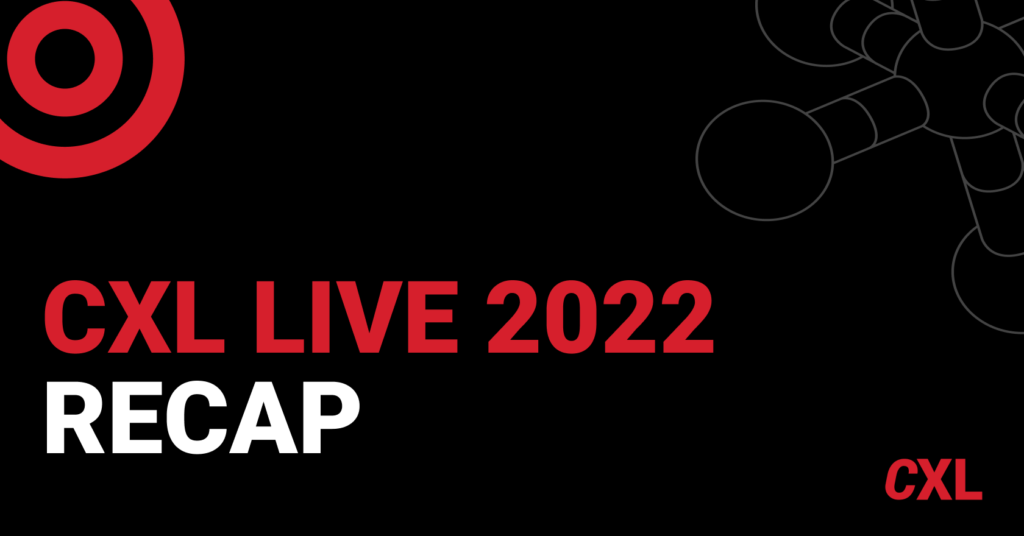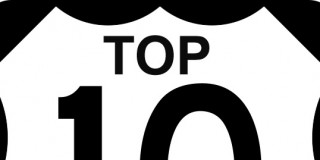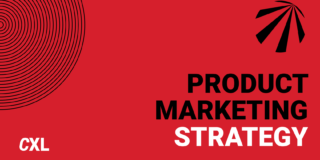CXL Live 2022 was a blast. Over 300 old and new faces flew to Austin to spend two days full of networking and talks on growth and experimentation. Add to that breakfast tacos, a lot of beer, and three parties.
Even though the Austin weather had some surprises in store for us, the tremendous effort to organize CXL Live pulled off the event through a (literal) storm and frenzy.
This conference focused on relationship building, and a lot of work was put into creating curated groups to have fruitful round table discussions with like-minded peers. However, that’s not to say content doesn’t matter.
It does, and we brought world-class marketers to deliver keynotes full of value on growth and experimentation. These are the highlights of each one.
Table of contents
- More networking and curated roundtables, less gurus and swag
- Peep Laja: “How to win”
- Ben Labay: “Testing to win”
- Dave Gerhardt: “Lessons I wish I knew as a first time B2B marketing leader”
- Emma Stratton: “Grow with messaging”
- Gaetano DiNardi: “Outdated B2B vs. Modern B2B”
- Casandra Campbell: “The secret growth ingredient most people ignore”
- Conclusion
More networking and curated roundtables, less gurus and swag
The most important factor for differentiation in CXL Live is its unique format.
Of course, we took care of the usual aspects of every offline marketing conference, and CXL Live 2022 brought together 300 returning attendees and first-timers, taking over a rooftop venue in downtown Austin.
But we put an even bigger focus on the value that smaller groups and relationship-building have. We wanted people to connect and discuss real problems and challenges with other peers. We arranged vetted and curated groups for roundtable discussions, and matched everyone with other like-minded people.
And we received amazing feedback on the quality of networking that people got:
CXL raised the bar and created an experience unlike any other marketing event I’ve ever been to. They figured out something many bigger events miss: it’s not about the gurus, swag, and booths.
Andrei Faji, Engagement Marketing @ PandaDoc
They focused almost exclusively on curating an environment where you get to talk about substantial topics with the brightest people in our industry.
CXL live is a marketing conference that gets it. It’s like they thought about the attendees and what they need and then designed a format focused on them. The small group roundtable discussions were amazing.
Gavin Braman, Co-Founder @ Drifting Creatives
Peep Laja: “How to win”

Peep started with a reality check: there have never been as many brands as there are today. Although more and more companies are joining the game, the stability of market positions is astonishing. Salesforce, for example, increased its revenue market share to 18.4% in the past years, according to a research by IDC.
Most of those positions aren’t likely to change. You can’t beat category kings, and the only exception for this is through tech disruption.
This is when the ‘double jeopardy law’ comes into play: the larger the market share, the more users and loyalty a brand will have. B2B buyers aren’t all-rational, and they will often follow and recommend tools they’ve heard of even if they’ve never used them.
You should also be aware of the law of shitty clickthroughs: all marketing strategies end up having shitty CTR because novelty fades and a first-to-market strategy doesn’t last.
Smaller brands have fewer users, but they’re also less loyal. They don’t usually fit within the consideration set where only category kings go. Your job as a marketer is to get inside it.
Peep mentioned three ways to get inside the limited consideration set:
- Innovation: create an objectively better product and you’ll achieve a transient advantage, just the way other category kings such as Tinder or Tesla did.
- Marketing: get a larger share of voice. Advertising can be seen as an insurance.
- Win beyond product: use a powerful narrative, positioning, messaging, content and differentiation strategy. This consists of dominating your competition, and out-converting by acquiring new customers in a cheaper way that your competitor does.
Those tactics allow you to fit within a unique JTBD (“job to be done”) framework. In order to have this positioning, make sure you answer three questions:
- What does your product do? By answering this, you will define the category in which your product fits.
- Who is it for? This will allow you to define an ICP that you will target.
- What are its use cases? This will define the problems that your product solves.
One of the key aspects to out-convert competitors and get in that JTBD framework is using effective messaging. However, when this does not happen, the symptoms of a poor messaging strategy are often difficult to stop.
Knowing which messages your buyers need to hear improves your marketing radically, and that is why Wynter has achieved solid positioning as a platform for message testing.
Just like Peep, other marketers from hypergrown products, such as David Cancel (founder at Drift) argue that product-based differentiation is vanishing. Your copy is now even more of an influence in why your visitors convert.
Ben Labay: “Testing to win”
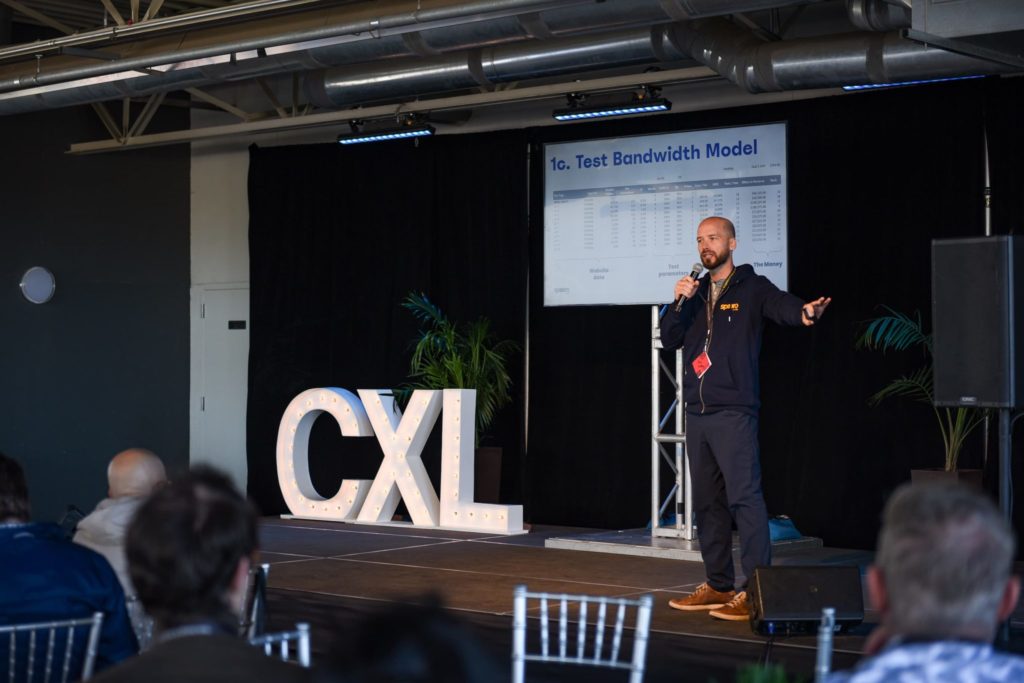
Ben delivered very powerful insights on growth, but he also used some of Daniel Layfield’s work in Codecademy as a case study for experimentation systems.
Speedo’s experimentation strategy for Codecademy was built around three questions:
- Where are you testing first? This allows Speero to understand the business priority and adapt their growth, pipeline and test bandwidth models.
- What are the priority customer problems and opportunities? This defines what to test by adapting to the customer priority.
- How will you act? This defines how to connect problem themes to a metric strategy, building a metric-driven action system.
We already had a really strong brand and top of funnel traffic. So we settled on growth levers at the bottom of the funnel–experimenting with pricing, the checkout page, plan mix, and our trial model.
Daniel Layfield, Growth Product Manager at Codecademy
Speero’s growth pyramid is divided into three phases:
- Acquisition: this includes free trials, demos, referrals, sign-ups, forms, PPC/SEO, typical CRO…
- Monetization: this includes paywalls, trial models, promotions, bundles, discount ladders, FITD products…
- Retention: this includes customer success, win-backs, LTV, one-two punch campaigns, loyalty programs, referral programs…
Codecademy’s experimentation focused on their customers and what they knew about them, and repeated wins deep in the funnel had an immediate impact and delivered growth for them.
They aimed at improving content clarity and navigation on the website experience, using KPIs such as the amount of “Sign-Up” CTAs clicked, sign-ups completed, company leads, and registration flow drop-offs.
If you want to grow beyond the local maximum, the only way to do that is through testing the strategic, most guarded parts of your business.
Daniel Layfield
Dave Gerhardt: “Lessons I wish I knew as a first time B2B marketing leader”
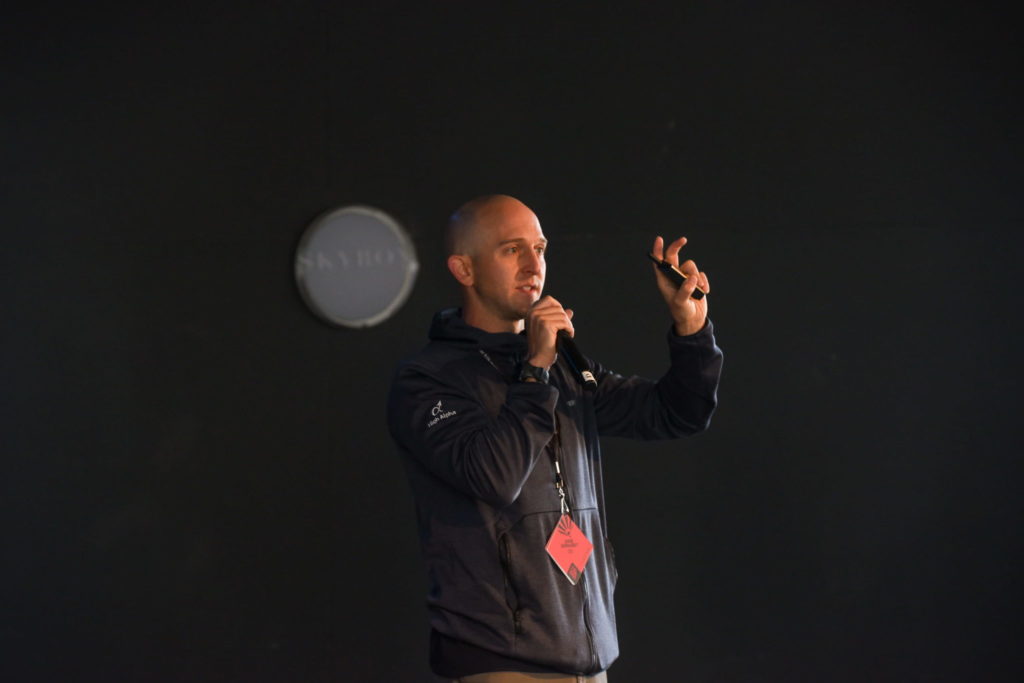
With his experience as a marketing manager first and a CMO now, Dave Gerhardt knows that being a marketing leader requires both marketing expertise and a set of marketing skills.
Dave suggested using the 70/30 rule when allocating resources and time on growth: spend 70% on what works right now, and 30% on what could work next year.
One of marketer leaders’ top priorities should be understanding what the CEO really cares about. They not only need to work well; they’re also required to explain how their work fits into company goals and master internal communication.
A way to do this is by making your story become a strategy. A marketing strategy should include a go-to-market plan that is sales-led and product assisted.
The marketing team should create its own momentum through feature launches, content campaigns, product launches, and announcements.
Product should be your main channel for customer acquisition, retention and expansion. This also includes understanding the segments you will sell to, and aligning your whole company on these things.
As a marketing leader, you should become comfortable making bets without perfect data, because they will rarely have it.
Ben Labay
Marketing should collaborate as a business function with sales, finance and ops, but you shouldn’t replace any of their tasks as a manager.
Emma Stratton: “Grow with messaging”
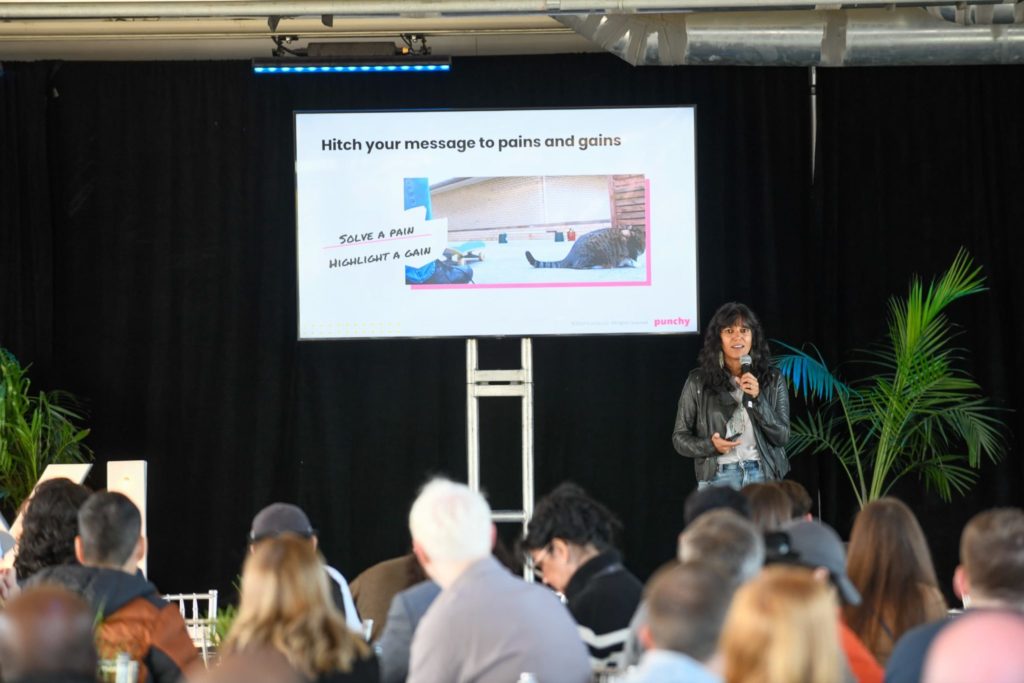
Messaging can make a good product look bad. Weak messaging strategies are hard to sell and market, with no differentiation and getting the wrong perception.
Strong messaging, on the other hand, is differentiating and easier to sell and market. Your strategy will either drive or slow growth. There’s no in between: it can bridge the gap between tech and people or close it.
Emma had one very actionable takeaway: avoid wordy phrases.
Lengthy sentences like “Innovate with action-based strategies” and “transform and accelerate your process” should be rewritten in a way that gets you closer to your customer.
To help with this, Emma shared three ways to strengthen your messaging:
- Give context, so that people understand your point fast. Put your solution in the context of their life.
- Be compelling, so that people actually care. Prospects only really care about their pains (needs and problems) and gains (desires and goals). Hitch your message this way: solve a pain and highlight a gain of your product.
- Make it clear, so that people aren’t confused. Avoid using jargon that sounds like a different language. Ask yourself what the jargon actually means, and then rewrite your messaging.
Gaetano DiNardi: “Outdated B2B vs. Modern B2B”
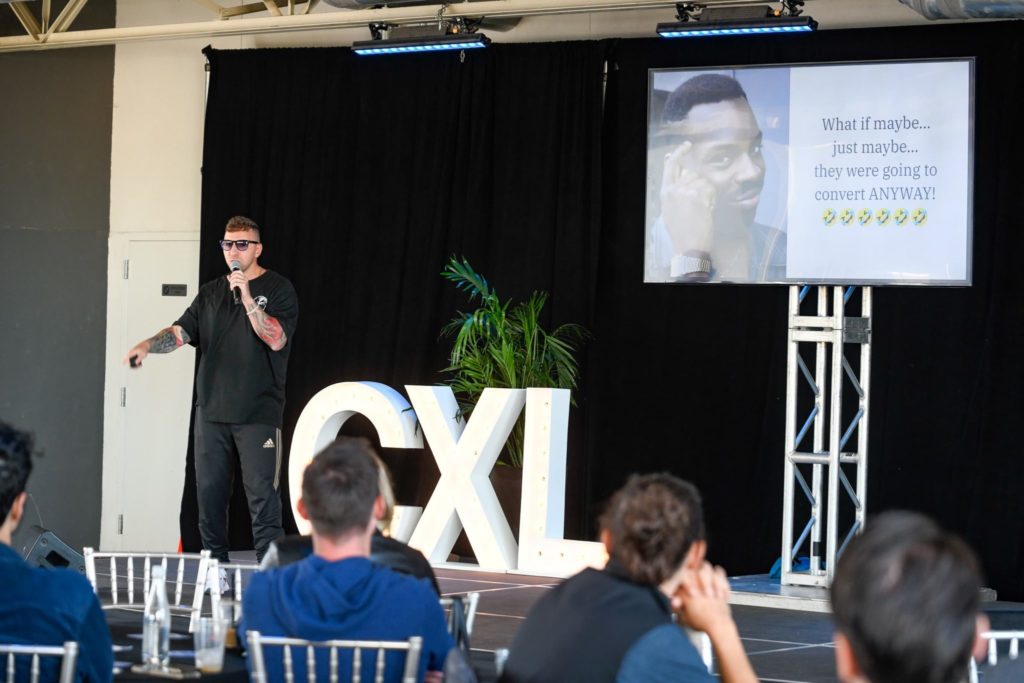
Gaetano delivered his insights on which indicators you should use for your demand gen program. He explained how lead generation uses a short term, sales-focused strategy. It has extremely low close rates, and high volumes of junk leads.
On the other hand, demand generation, on the other hand, uses a long term, education-focused strategy. Its effectiveness is measured by engagement and leading indicators, which are the usual metrics in this case (traffic, clicks, impressions, time on page, or branded search volume growth).
Don’t sleep on assisted conversions: these are any pages that are visited on the path to a website conversion.
Gaetano DiNardi
Then, there’s demand capturing. Gaetano explained that it markets to problem-aware, solution-seeking people. It has high close rates and shorter sales cycles, and some of the usual metrics are lagging indicators (demos attended, proposals sent, and average deal size).
If you target demand capture, you need to use intent channels that include paint point SEO, PPC, review websites, affiliates and aggregators, or intent data.
And the content you create will differ depending on the channel: long-tail, pain-point content for SEO, or conversion-engineered landing pages for PPC.
Gaetano also touched on the role that email has in B2B marketing: it educates, builds community, helps provide free trials, does product marketing, and works towards customer success. When done right, it makes users feel valued.
Every failing B2B marketing program is driven by the misalignment of people, process and strategy. This may occur when wrong players are playing in the wrong positions on the field, wrong strategies are being deployed to the wrong channels, or wrong channels are being measured with the wrong metrics.
Gaetano DiNardi
Casandra Campbell: “The secret growth ingredient most people ignore”

Casandra presented a framework for an experimentation program that allows you to establish strong assumptions based on evidence, and ultimately achieve sustainable growth.
Strong assumptions are essential for good decision making. In order to have sustainable growth, you will have to reject poor ideas and discern the good ones that will end up being picked.
In order to develop strong assumptions using evidence, you should start by informing those assumptions by both mining your data and looking externally at the industry and competitors.
Next step is validating your assumptions with tests. An important question to ask yourself here is: “what data do I need to collect to prove that my assumptions are reasonable?“:
- For this, you can resort to the usual experimentation, ranging from A/B testing and pilots to MVPs.
- You can also perform more classical research, such as surveys, interviews and instrumentation.
After that, it’s time to debate about your assumptions with others. Leverage subject matter experts for input to help you fill in more evidence, invite others to provide feedback, or contribute to stronger assumptions through peer review.
The final stage of Casandra’s experimentation framework is the one where you present your results with the gathered evidence. You should expose assumptions in your work once you’ve established them after proper testing.
Conclusion

CXL Live is all about relationship building. It focuses on building authentic relationships and spending quality time with other like-minded people. We curated groups to make sure everyone met people with a similar role at a similar company, working on the same challenges.
Of course, content is still a key part of every marketing conference, and we brought our A-game for CXL Live 22.
It’s not easy to condense the value of those 6 sessions from top 1% marketers into a short blog post. I simply suggest attending the next CXL Live if you want to make the most of these keynotes.
The real value of CXL Live is not on any recycled content that you could get just by reading a post.
It’s in the discussion and relationships, and a engaging format that focuses on what attendees need. That’s why the best feedback came from all the marketers who got to discuss real problems and challenges with other peers.
This was a different kind of conference, one that stands out in a marketing calendar that is lacking, full of events with recycled content and death by PowerPoint. The ROI on relationships is truly incalculable.
Hands down the best conference I’ve been to but, more importantly, finally getting to meet in real life all the people who have for too long been just names on LinkedIn. In-person events FTW!
Jonny Longden, Director, Website Experience & Journey Further
